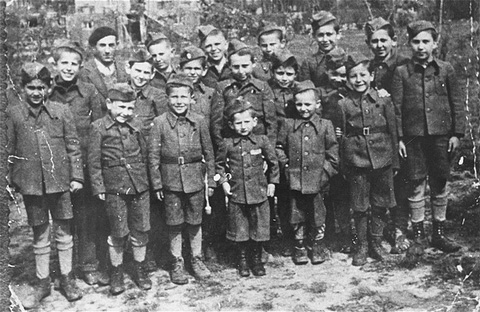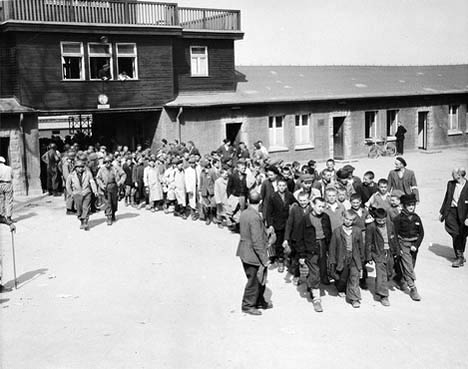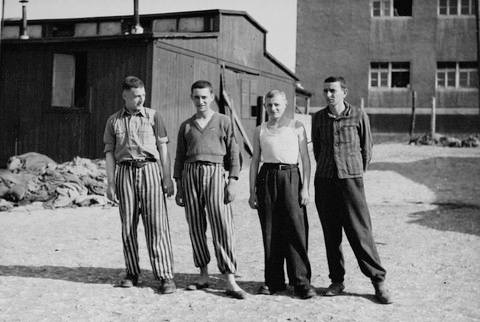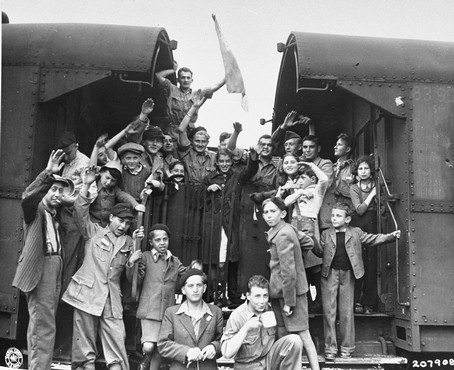Child Survivors of Buchenwald Among the child survivors of the Buchenwald concentration camp, shown in the center of the photograph above, was four-year-old Josef Schleifstein. The Communist prisoners, who were in charge of the day-to-day administration of the camp, made sure that the children were well cared for. Note the adult man in the back row wearing a beret to identify himself as a Communist. The children in the photo are wearing clothes made for them by the Americans out of German uniforms. As prisoners in the camp, they wore striped uniforms just like the other prisoners. The photo below shows Josef Schleifstein, posing in his camp uniform, a year after he was liberated.  Josef Schleifstein is also shown in the photo below. He is sitting on the running board of a truck from the United Nations Relief and Rehabilitation Administration.  According to the United States Holocaust Memorial Museum, the little Jewish boy in the photo above was born Janek Szlajfaztajn on March 7, 1941 in Sandomierz, Poland during the German occupation. His parents were Izrael and Esther Szlajfaztajn. The family was moved into the Sandomierz ghetto in June 1942. After the liquidation of the ghetto, the family was moved to Czestochowa, a city in Poland, where Izrael and Esther were put to work in one of the HASAG factory camps. During this period, their son was placed in hiding in the area. Izrael Szlajfaztajn was then sent to the Letzium Work Camp in the Radom District, where he worked for a firm called Ralnik from October 1942 till September 1943. He worked in Makashin, near Sandomierz, from September till December 1943 and in a HASAG ammunition factory in Kielce from December 1943 to approximately November 1944. In January 1945, when the HASAG camps were closed and their operations transferred to Germany, the Szlajfaztajn family was deported to Germany. Esther was sent to the Bergen-Belsen concentration camp. Izrael and Janek were taken to Buchenwald where they arrived on January 20, 1945. Izrael concealed little Janek in a large sack in which he carried his leather-working tools. The child could not remain hidden for long in the camp, but his life was spared, in part because the Germans valued Izrael's craftsmanship and in part because they took a liking to the child. The SS guards came to treat Janek as a camp mascot, and even had him appear at roll calls wearing his child-sized striped uniform. Despite this special treatment, Janek remembered being lined-up for execution at one point and his father intervening at the last moment to save him. He also remembered being very sick during his imprisonment and living in a hospital for a time. Soon after their liberation in Buchenwald, Izrael and Janek were taken to Switzerland for medical treatment. Some months later, they were reunited with Esther in the town of Dachau, where they lived until emigrating to the U.S. in 1947. Israel Meir Lau was an 8-year-old orphan when he was liberated from Buchenwald. Most of his family members had been gassed at Treblinka. Lau and his mother escaped deportation to the death camps, but were imprisoned in the Piortrkow ghetto until November 1944 when Lau and his brother Naftali were sent to the Czenstochov forced labor camp and then to the Buchenwald camp. After he was liberated, Lau emigrated to Israel on a ship with other orphaned refugee children. Lau served as the chief Ashkenazi rabbi of Israel from 1993 to 2003. He currently serves as the chief rabbi of Tel Aviv. In November 2008, Lau was appointed the chairman of the Yad Vashem (museum) Council. After he was liberated from Buchenwald, Lau said his rescuer was a person named Fyodor from Rostow, who gave him ear warmers and treated him like a son in Block 8 where both were prisoners. Kenneth Waltzer, a professor at Michigan State University has identified this person as 18-year-old Fyodor Michajlitschenko, who had been arrested by the Gestapo in 1943.   In the photo above, some of the 904 orphans at Buchenwald are shown leaving the camp. The gate house of the Buchenwald camp is in the background on the right. Most of the Buchenwald orphans were teenagers, and only 30 of them were under the age of 13.    Most of the 904 children who were in the camp when it was liberated were orphans. The American army chaplains, Rabbi Herschel Schacter and Rabbi Robert Marcus, contacted the offices of the OSE (Oeuvre de Secours aux Enfants), the Jewish children's relief organization in Geneva, Switzerland. The OSE made arrangements to send 427 of the children to France, 280 to Switzerland and 250 to England. On June 2, 1945, OSE representatives arrived in Buchenwald and along with Rabbi Marcus, accompanied the transport to France. Rabbi Schacter escorted the second transport to Switzerland. Elie Wiesel, the most famous survivor of the Buchenwald camp, was among the orphans who were sent to France. Later, he emigrated to America where he was instrumental in getting the $167 million U.S. Holocaust Museum built near the Capitol Mall in Washington, D.C. Wiesel has written many books, including "Night," a memoir about his ordeal in the Nazi camps. Among his many accomplishments, he was awarded the Nobel Peace Prize. The following words by Elie Wiesel are often quoted: Every Jew, somewhere in his being, should set apart a zone of hate - healthy, virile hate -- for what the German personifies and for what persists in the German. To do otherwise would be a betrayal of the dead. Old photos of BuchenwaldBuchenwald SurvivorsCongressmen & ReportersEdward R. Murrow ReportLiberation ClaimsLiberation DayFirst American liberatorsGerman civilians tour BuchenwaldExhibits put up by prisonersMore exhibits at BuchenwaldBack to Buchenwald liberationHomeThis page was last updated on June 28, 2012 |